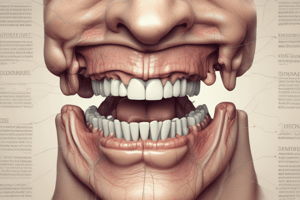Podcast
Questions and Answers
What is the primary mechanism by which sugar contributes to enamel demineralization?
What is the primary mechanism by which sugar contributes to enamel demineralization?
- Bacteria convert sugar into lactic acid, which lowers the pH and promotes demineralization. (correct)
- Sugar causes the enamel to become more porous and susceptible to demineralization.
- Sugar causes the saliva to become more acidic.
- Sugar directly dissolves the enamel crystals.
Which of the following is the most important role of saliva in maintaining tooth integrity?
Which of the following is the most important role of saliva in maintaining tooth integrity?
- Saliva creates a physical barrier to protect the enamel from demineralization.
- Saliva provides a constant source of calcium and phosphate ions for remineralization. (correct)
- Saliva contains enzymes that break down sugar and prevent bacterial growth.
- Saliva neutralizes the acidity caused by sugar consumption.
How do soft drinks and fruit juices contribute to enamel demineralization?
How do soft drinks and fruit juices contribute to enamel demineralization?
- They increase the production of saliva, leading to a more acidic environment.
- They contain high concentrations of free sugars, which bacteria can convert into lactic acid. (correct)
- They have a low pH, which directly dissolves the enamel crystals.
- They contain additives that weaken the enamel structure.
What is the primary function of the hydroxyapatite (HA) crystals in tooth enamel?
What is the primary function of the hydroxyapatite (HA) crystals in tooth enamel?
How does the combination of sugar consumption and acidic beverages increase the likelihood of enamel demineralization?
How does the combination of sugar consumption and acidic beverages increase the likelihood of enamel demineralization?
What is the primary function of Streptococcus mutans bacteria in the context of enamel demineralization?
What is the primary function of Streptococcus mutans bacteria in the context of enamel demineralization?
Which of the following preventive measures directly addresses the availability of substrate for bacterial metabolism?
Which of the following preventive measures directly addresses the availability of substrate for bacterial metabolism?
What is the primary reason for confining sugar consumption to specific meal times?
What is the primary reason for confining sugar consumption to specific meal times?
Which of the following practices directly promotes remineralization of tooth enamel?
Which of the following practices directly promotes remineralization of tooth enamel?
Which preventive measure helps detect and treat initial signs of demineralization promptly?
Which preventive measure helps detect and treat initial signs of demineralization promptly?
What is the primary purpose of regular brushing and flossing in the context of preventing tooth decay?
What is the primary purpose of regular brushing and flossing in the context of preventing tooth decay?
Which of the following preventive measures directly neutralizes the acidic environment in the mouth?
Which of the following preventive measures directly neutralizes the acidic environment in the mouth?
Flashcards are hidden until you start studying
Study Notes
Effect of Sugar on Enamel Demineralization
Demineralization refers to the removal of minerals, primarily calcium and phosphorus, from the hydroxyapatite (HA) crystals of hard tissue, such as enamel, dentin, cementum, and bone. The saliva plays a crucial role in maintaining tooth integrity by acting as a buffer against acid and providing a constant source of calcium and phosphate ions necessary for remineralization. However, excessive sugar consumption can disrupt this balance and contribute to the demineralization process, leading to tooth decay.
How Sugar Contributes to Demineralization
Bacteria, particularly Streptococcus mutans, utilize sugars as a substrate for energy production. These bacteria convert sugars into organic compounds and lactic acid through the process of fermentation. The accumulation of lactic acid in the mouth leads to a drop in pH, making the environment more acidic and promoting demineralization of tooth enamel.
Soft drinks and fruit juices contain high concentrations of free sugars, which can exacerbate demineralization. These beverages often have low pH values, further contributing to the acidic environment that accelerates demineralization. Consuming sugar in combination with these beverages increases the likelihood of demineralization and tooth decay.
Prevention Strategies
To minimize the risk of demineralization and tooth decay, several preventive measures can be taken:
Limiting Sugar Intake
Restricting sugar intake, particularly the consumption of sweets, candies, and sugary beverages, reduces the availability of substrate for bacterial metabolism and thereby reduces the production of acid that contributes to demineralization.
Timing of Sugar Consumption
Frequent consumption of sugary foods or beverages throughout the day provides continuous fuel for bacterial growth and acid production, increasing the risk of demineralization. Confining your sugar consumption to specific meal times allows for better management of acid exposure.
Brushing and Flossing
Regular brushing and flossing help remove plaque, which reduces the chance of bacterial colonization and subsequent demineralization. Maintaining good oral hygiene practices is essential in preventing tooth decay.
Saliva Production
Stimulating saliva production through hydration, sucking on sugarless candies, or chewing sugarless gum promotes salivary flow, which neutralizes the acidic environment and facilitates remineralization of tooth enamel.
Professional Cleanings
Regular dental cleanings and checkups ensure that any initial signs of demineralization are detected and treated promptly, helping to maintain overall oral health.
Studying That Suits You
Use AI to generate personalized quizzes and flashcards to suit your learning preferences.




